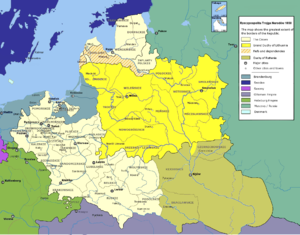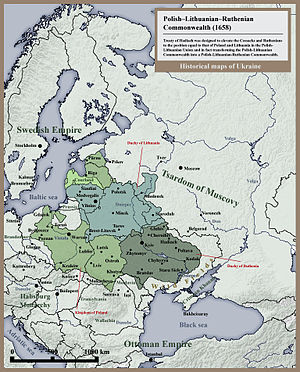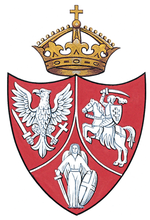- Polish–Lithuanian–Ruthenian Commonwealth
-
This is a 19th century design for a coat of arms of a proposed Polish–Lithuanian–Ruthenian Commonwealth which never came into being. It consists of the Polish White Eagle, the Lithuanian Pahonia and Ruthenian Archangel Michael

Polish–Lithuanian–Ruthenian Commonwealth (Polish: Rzeczpospolita Trojga Narodów, Commonwealth of Three Nations) was a proposed (but never actually created) European state in the 17th century that would replace contemporal Polish–Lithuanian Commonwealth. The creation of a Duchy of Ruthenia was considered at various times, particularly during the 1648 Cossack insurrection against Polish rule in Ukraine. Such a Ruthenian duchy, as proposed in the 1658 Treaty of Hadiach, would have been a full-fledged member of the Polish–Lithuanian Commonwealth, which would thereby have become a tripartite Polish–Lithuanian–Ruthenian Commonwealth. In May 1659, the Polish Diet (Sejm) ratified the treaty with an emended text.[1] The idea of a Ruthenian Duchy within the Commonwealth was completely abandoned.[2]
The Canadian historian Paul Robert Magosci believes that it happened due to divisions among the Cossacks and Muscovite invasion[3] which, however, both occurred much earlier than the Treaty of Hadiach was signed. The Russian historian Tairova-Yakovleva considers the resistance of the Polish society and the papal pressure as the reasons for the incomplete ratification.
See also
- Międzymorze
- Polish-Lithuanian-Muscovite Commonwealth
- Ruthenian Voivodship
References
- ^ Władysław Konopczyński (1936). Dzieje Polski nowożytnej (A History of Modern Poland. Second Edition, Warsaw 1986, p.27). ISBN 83-211-0730-3 : W izbach dużo było narzekania na to, że nowy układ łamie unię lubelską (...) Ostatecznie nad tymi rozczeniami, jak i nad protestem nuncjusza [Piotra Vidoniego] oraz biskupów, sejm przeszedł do porządku dziennego. 12 maja, w dzień Wniebowstąpienia, król, prymas i senat zaprzysięgli ugodę.
- ^ Т.Г. Таирова-Яковлева, Иван Выговский // Единорогъ. Материалы по военной истории Восточной Европы эпохи Средних веков и Раннего Нового времени, вып.1, М., 2009: Под влиянием польской общественности и сильного диктата Ватикана сейм в мае 1659 г. принял Гадячский договор в более чем урезанном виде. Идея Княжества Руського вообще была уничтожена, равно как и положение о сохранении союза с Москвой. Отменялась и ликвидация унии, равно как и целый ряд других позитивных статей.
- ^ Paul Robert Magocsi (1996). A History of Ukraine. Toronto: University of Toronto Press, pp.221-225. ISBN 0802008305
External links
Categories:- History of Lithuania (1569–1795)
- History of Poland (1569–1795)
- History of Ukraine
- History of Belarus (1569–1795)
- Rus
- Polish history stubs
- Lithuanian history stubs
- Belarusian history stubs
- Ukrainian history stubs
- East Slavic history stubs
Wikimedia Foundation. 2010.



